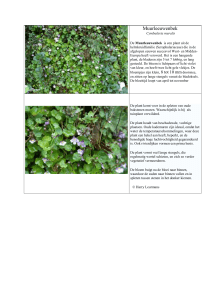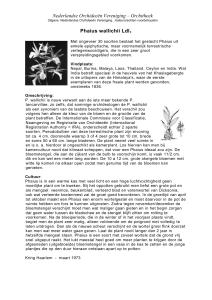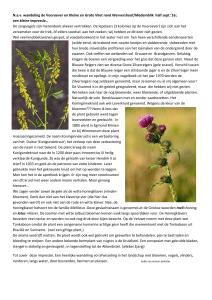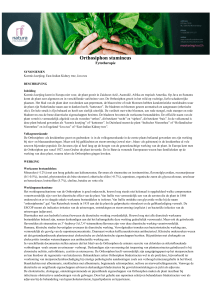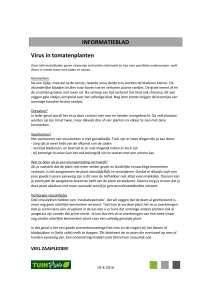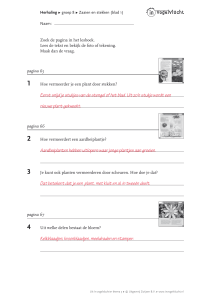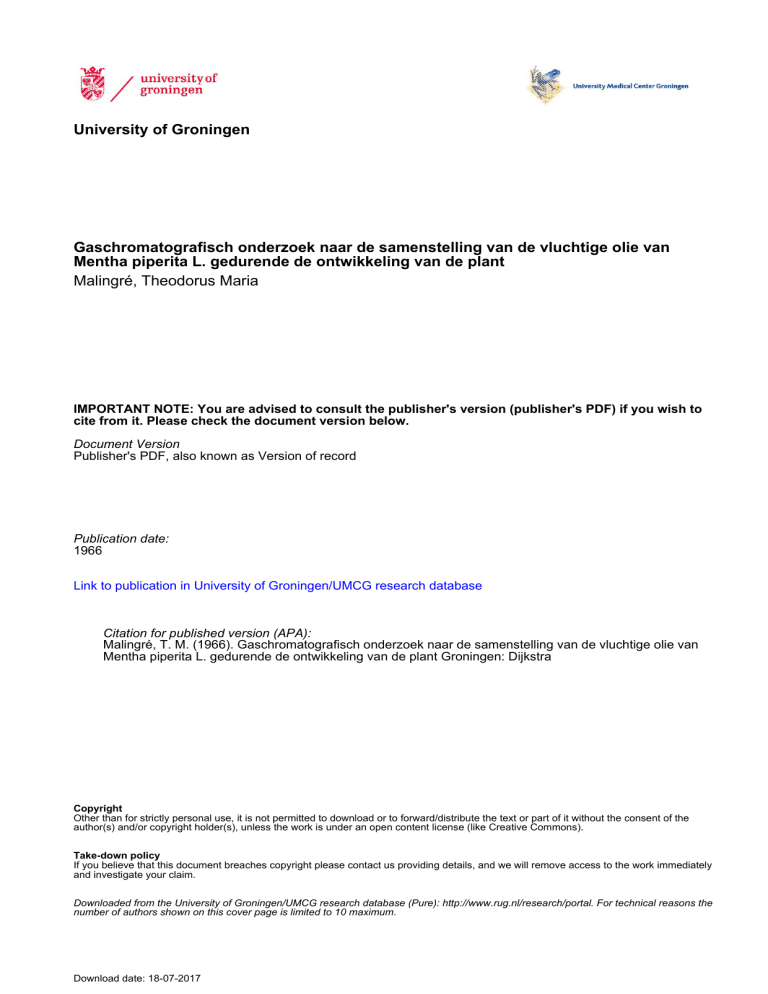
University of Groningen
Gaschromatografisch onderzoek naar de samenstelling van de vluchtige olie van
Mentha piperita L. gedurende de ontwikkeling van de plant
Malingré, Theodorus Maria
IMPORTANT NOTE: You are advised to consult the publisher's version (publisher's PDF) if you wish to
cite from it. Please check the document version below.
Document Version
Publisher's PDF, also known as Version of record
Publication date:
1966
Link to publication in University of Groningen/UMCG research database
Citation for published version (APA):
Malingré, T. M. (1966). Gaschromatografisch onderzoek naar de samenstelling van de vluchtige olie van
Mentha piperita L. gedurende de ontwikkeling van de plant Groningen: Dijkstra
Copyright
Other than for strictly personal use, it is not permitted to download or to forward/distribute the text or part of it without the consent of the
author(s) and/or copyright holder(s), unless the work is under an open content license (like Creative Commons).
Take-down policy
If you believe that this document breaches copyright please contact us providing details, and we will remove access to the work immediately
and investigate your claim.
Downloaded from the University of Groningen/UMCG research database (Pure): http://www.rug.nl/research/portal. For technical reasons the
number of authors shown on this cover page is limited to 10 maximum.
Download date: 18-07-2017
SA1HENVATTING Het doel van het beschreven onderzoek was door middel van gas­
chromatografie, gecombineerd met andere analysemethoden, de
samenstelling van de vluchtige olie van 1Mentha piperita L. en de
veranderingen hierin gedurende de ontwikkeling van de plant, te
bepalen en uit de resultaten van het onderzoek tot een hypothese
over de vorming van de bestanddelen te komen, waarbij onder­
scheid gemaakt wordt tussen de koolwaterstofterpenen en de zuur­
stof bevattende bestanddelen.
N a chemotaxonomische beschouwingen over het geslach t JVIentha,
sectie 111enthastrum, en een beschrijving van de proefplant, de teelt
en de verwerking, wordt een overzicht gegeven van de tot nu be­
kende bestanddelen van pepermuntolie.
Ais methoden voor het onderzoek van de vluchtige oIle worden
kwalitatieve en kwantitatieve gaschromatografie, kolomchromato­
grafie en dunnelaagchromatografie beschreven. Bij het gaschroma­
tografisch onderzoek werd naast gevulde kolommen gebruik ge­
maakt van capillaire en preparatieve kolommen. Ais hulpmiddel
voor de identificatie van onbekende bestanddelen werd het gecom­
bineerd chemisch en gaschromatografisch onderzoek gelntrodu­
ceerd. Verder werd voor de identificatie gebruik gemaakt van chro­
matografische diagram men en infraroodspectrometrie.
Speciale aandacht werd gewijd aan de isolering van de vluchtige
olie, zoals deze in de plant aanwezig is. De vluchtige olie werd ge­
wonnen door destillatie met onverzadigde waterdamp gevolgd door
een gravimetrische bepaling of door destillatie met verzadigde wa­
terdamp gevolgd door een volumetrische bepaling van de vluchtige
olie. Bij de laatste methode werd gebruik gemaakt van een
samengestelde hulpvloeistof bij de destillatie die tevens als inwen­
dige standaard bij het gaschromatografisch onderzoek kan fungeren.
Bij het kwalitatief onderzoek werden de volgende koolwater­
stofterpenen in de onderzochte olie aangetoond: Cl-pineen, Cl-fen­
cheen, ,B-fencheen, myrceen, sabineen, ,B-pineen, Cl-fellandreen, Cl­
terpineen, p-cymeen, limoneen, ,B-fellandreen en terpinoleen, en de
zuurstofverbindingen: 1,8-cineol, octylacetaat, 3-octanol, mentho­
furan, trans-sabineenhydraat, menthon, isomenthon, menthylace­
taat, neomenthol, menthol, pulegon en piperiton. Naast de gelden­
116
tificeerde bestanddelen W I
nenten de ester- of de alel
alcoholen het secundaire
van een dubbele binding,
worden vastgesteld.
De aanwezigheid van pi)
hoogkokend koolwatersto
nemelijk gemaakt.
Het percentage vlucht
blad ouder is. De gewicht~
aanvankelijk toe tot een
sertie Xln of IX en per i
sen de bloemknopvormir
een geleidelijke daTing Op1
De gewichtshoeveelheden
men alle toe tot een mal
samenvalt met het omsl
gelijkmatig afnemen, wa'
de olie. Een bijzondere
menthon-menthol en de
door hydratatie van het
aangenomen worden voor
De hoeveelheid menthon
heid menthol na het ben
van menthon in menthc
gaat door bij het begin v;
omgezet in menthylacetaa
tot voortzetten na het 01
De bloemolie wijkt af "
percentages koolwaterst c
piperiton. Het hoge mer
stengels van uitlopers 1<3
Een schema wordt gel!
koolwaterstoffen via ffiI
mogelijke vorming va.n d
mende, koolwaterstofteq
U itgezonderd de Ol11Z1
cineol en sabineen in sal
band gelegd worden tus
penen en de zuurstofbc'
tificeerde bestanddelen werden van een aantal onbekende compo­
nenten de ester- of de alcoholfuncte aangetoond en kon van enkele alcoholen het secundaire of tertiaire karakter en de aanwezjgheid van een dubbele binding in de nabijheid van de hydroxy1groep worden vastgesteld. De aanwezigheid van piperitonoxide, neomenthylacetaat en een hoogkokend koolwaterstofterpeen in de vluchtige olie werd aan­ nemelijk gemaakt. Ret percentage vluchtige olie per blad is lager naarmate het
blad ouder is. De gewichtshoeveelheid vluchtige olie per blad neemt
aanvankelijk toe tot een maximum bij de volwassen plant bij in­
sertie XIII of IX en per insertiehoogte op een tijdstip dat ligt tus­
sen de bloemknopvorming en de bloei ("omslagpunt"), waarna
een geleidelijke daling optreedt die na enige weken tot nul nadert.
De gewichtshoeveelheden van de afzonderlijke bestanddelen ne­
men alle toe tot een maximum dat voor de meeste verbindingen
samenvalt met het omslagpunt, waarna de meeste componenten
gelijkmatig afnemen, wat wijst op een integraal verclwijnen van
de olie. Een bijzondere ontwikkeling vertonen limoneen-cineol,
menthon-menthol en de esters. De hoeveelheid cineol neemt toe
door hydratatie van het limoneen, een dergelijke hydratatie kan
aangenomen worden voor de omzetting sabineen-sabineenhydraat.
De hoeveelheid menthon bereikt het maximum voor, de hoeveel­
heid menthol na het bereiken van het omslagpunt. De omzetting
van menthon in menthol begint voor de bloemknopvorming en
gaat door bij het begin van de bloei, het gevormde menthol wordt
omgezet in menthylacetaat. Ook de vorming van andere esters neigt
tot voortzetten na het omslagpunt.
De bloemolie wijkt af van de bladolie en is gekenmerkt door lage
percentages koolwaterstofterpenen en hoge gehalten pulegon en
piperiton. Ret hoge menthofurangehalte in bloemen, toppen en
stcngels van uitlopers kan verklaard worden door de lichtinvloed.
Een schema wordt gegevcn van de vorming van monoterpeen­
koolwaterstoffen via mevalonzuur uit acetyl-eoA, en van de
mogelijke vorming van de belangrijkste, in pepermuntolie voorko­
mende, koolwaterstoft erpenen via carboniumionen.
Uitgezonderd de omzetting door hydratatie van limoneen in
cineol en sabine en in sabineenhydraat kon gecn rechtstreeks ver­
band gelegd worden tussen de vorming van de koolwaterstofter­
penen en de zuurstofbevattende bestanddelen. De vorming van
117
be ide groepen bestanddelen blijkt niet rechtstreeks met elkaar
samen te hangen. De mogelijkheid wordt geopperd dat naast
isopentenylpyrofosfaat ook dimethylacryl-CoA in de plant aan­
wezig is, waardoor alle voorwaarden voor de vorming van de kool­
waterstofterpenen en bestanddelen met een hoge oxidatietrap aan­
wezig zijn.
Gedurende de ontwikkeling van de plant blijkt een tendens tot
hydratatie en reductie van de bestanddelen te bestaan gevolgd
door een verestering van de gevormde a1coholen. Al deze reacties
vragen energie. Blijkbaar geschiedt de vorming van de zuurstof­
rijke verbindingen in de zeer jonge blaadjes, die door hun relatief
klein oppervlak weinig licht ontvangen, terwijl bij de meer ontwik­
kelde bladeren, met hun groter oppervlak, de vorming van de ge­
reduceerde verbindingen sterker wordt.
U8
The purpose of the inv
of the composition of th
change in this composit
means of gaschromatot
ods of analysis, and to
about the formation of I
between the hyclrocarbo
ponents.
After chemulaxonom:
Section M enthastrum, a
ture and the treatment,
peppermint-oil known
As methods for the i
and quantitative gasch l
thin-Iayerchromatograp
graphic investigation r
were used. As an exped
ponents, the combined
gation was introduced.
infrared-spectrometry \
Special attention wa~
present in the plant. T
with unsaturated aquec
mination or through dis
lowed by a volumetric
latter method a compo i
lation which can also it
matographic investigati
At the qualitative in
penes were shown in tl
fenchene, myrcene, sabi
p-cymene, limonene, {J­
gene compounds: 1,8-ci
trans-sabinenehydrate,
neomenthol, menthol, t
Beside the identified
SUMMARY The purpose of the investigation described was the determination
of the composition of the volatile oil of Mentha piperita L. and the
change in this composition during the development of the plant by
means of gaschromatographic analysis combined with other meth­
ods of analysis, and to come through the results to a hypothesis
about the formation of the components, where a distinction is made
between the hydrocarbon terpenes and the oxygene containing com­
ponents.
After chemotaxonomal observations about the family of Mentha,
Section M enthastru1it, and a description of the testplant, the cul­
ture and the treatment, a survey is given of the components of the
peppermint-oil known up till now.
As methods for the investigation of the volatile oil qualitative
and quantitative gaschromatography, columnchromatography and
thin-layerchromatography are described. With the gaschromato­
graphic investigation packed, capillary and preparative columns
were used. As an expedient for the identification of unknown com­
ponents, the combined chemical and gaschromatographic investi­
gation was introduced. In addition chromatographic diagrams and
infrared-spectrometry were used for the identification.
Special attention was paid to the isolation of the volatile oil, as
present in the plant. The volatile oil was obtained by distillation
with unsaturated aqueous vapour followed by a gravimetric deter­
mina tion or through distillation with saturated aqueous vapour fol­
lowed by a volumetric determination of the volatile oil. With the
latter method a compound auxiliary liquid was used at the distil­
lation which can also function as internal standard at the gaschro­
matographic investigation.
At the qualitative investigation the following hydrocarbon ter­
penes were shown in the investigated oil: a-pinene, a-fenchene, ~­
fenchene, myrcene, sabinene, ~-pinene, a-phellandrene, a-terpinene,
p-cymene, limonene, ~-phellandrene and terpinolene and the oxy­
gene compounds: 1,8-cineol, octylacetate, 3-octanol, menthofuran,
trans-sabinenehydrate, menthone, isomenthone, menthylacetate,
neomenthol, menthol, pulegone, and piperitone.
Beside the identified components, the ester- or alcoholfunction
119
was shown of a number of unknown components and, of a few al­
cohols, the secondary or tertiary character and the presence of a
double bound in the vicinity of the hydroxylgroup could be deter­
mined. The presence of piperitonoxide, neomenthylacetate and a
hydrocarbon terpene of high boilingpoint in the volatile oil was
made acceptable.
The percentage of volatile oil per leave is lower as the leave
gets older.
The quantity of weight of volatile oil per leave at first increases to
a maximum, with the fullgrown plant at insertion VIII or IX and
per insertionheight at a moment which lies between the forming
of the flowerbud and the actual flowering ("changing point"),
after which a gradual decrease takes place, which approaches zero
after a few weeks. The quantities of weight of the separate compo­
nents all increase to a maximum which for most compounds coin­
cides with the changing point, after which most components de­
crease evenly, which points to an integral disappearance of the oil.
Limonene-cineol, menthone-menthol and the esters show a special
development. The quantity of cineol increases through hydratation
of the limonene, a similar hydratation can be accepted for the con­
version sabinene-sabinenehydrate. The menthone quantity reaches
the maximum before the changing point, the menthol quantity
after. The change of menthone into menthol begins before the form­
ing of the flowerbud and continues during the beginning of the
flowering, the menthol formed changes into menthylacetate. In the
same way the forming of other esters is inclined to continue after
the changing point.
The flower-oil deviates from the leave-oil and is characterized
by low percentages of hydrocarbon terpenes and high percentages
of pulegone and piperitone. The high percentage of menthofuran
in flowers, tops and stems of offshoots can be explained through the
influence of light.
An outline is given of the forming of monoterpene hydrocarbons
via mevalonic acid from acetyl-CoA, and of the possible forming
of the most important, in peppermint-oil occurring, hydrocarbon
terpenes via carboniumions.
With the exception of the conversion through hydratation of
limonene into cineol and sabinene into sabinenehydrate no direct
connection could be found between the forming of hydrocarbon
terpenes and oxygene containing components. The forming of the
120
two groups of componl
with each other.
The possibility is put
phate, dimethylacryl-Cc
this all conditions for
and components with h
During the developm
dency for hydratation ;
by an esterification of t
energy. Apparently the
pounds takes place in 1
light because of their re
developed leaves, with
duced compounds beco:
two groups of components appears to have no direct connection
with each other.
The possibility is put forward that besides isopentenylpyrophos­
phate, dimethylacryl-CoA is also present in the plant, and through
this all conditions for the forming of the hydrocarbon terpenes
and components with high oxidation degrees are present.
During the development of the plant there appears to be a ten­
dency for hydratation and reduction of the components, followed
by an esterification of the alcohols formed. All these reactions need
energy. Apparently the forming of the oxygene containing com­
pounds takes place in the very young leaves, which receive little
light because of their relatively small surface, while with the more
developed leaves, with their larger surface, the forming of the re­
duced compounds becomes stronger.
121

